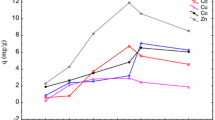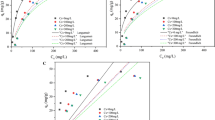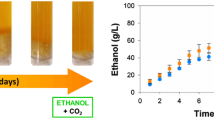Summary
Cells ofSaccharomyces cerevisiae adsorb sorbic acid within a brief period. The amount of acid adsorbed depends on the yeast cell mass and sorbic acid concentration. As much more sorbic acid is adsorbed at pH 3 than at pH 7 it may be assumed that it is the undissoziated molecules that are adsorbed by the yeast cells. However, no accumulation of sorbic acid is observed with in the yeast cells, for the acid is quantitatively present in the medium after an incubation of several days, if no degradation has occurred. The concentration of sorbic acid is greatly increased within the space surrounding the cells by adsorption; this is most likely of importance for the inhibition of cell growth. A small part of the sorbic acid is decomposed by the yeast cells, independent of the pH of the medium. The mode of degradation is unknown, but this part of sorbic acid is converted into a form that cannot be analyzed by UV-absorption. Yeast cells growing in the presence of sorbic acid (100 mg/l) tend to produce pseudomycelium. It is theorized that the disturbance of cell growth may be caused by a reaction of sorbic acid with thiol groups of the surface of the yeast cell.
Zusammenfassung
Zellen vonSaccharomyces cerevisiae adsorbieren innerhalb kurzer Zeit Sorbinsäure. Die Menge der adsorbierten Säure ist abhängig von der Hefemasse und der Sorbinsäurekonzentration. Da bei pH 3 wesentlich mehr Sorbinsäure adsorbiert wird als bei pH 7, kann angenommen werden, daß die undissozüerten Moleküle adsorbiert werden. Es kommt jedoch nicht zu einer Anreicherung von Sorbinsäure in den Hefezellen, denn sofern kein Abbau erfolgt, kann die Säure nach einigen Tagen quantitativ im Medium wiedergefunden werden. Durch die Adsorption wird die Sorbinsäurekonzentration im Bereich der Zellen erhöht, was wahrscheinlich für die Hemmwirkung von Bedeutung ist. Unabhängig vom pH-Wert des Mediums wird von Hefen ein Teil der Sorbinsäure abgebaut bzw. so verändert, daß ein analytischer Nachweis auf Grund der UV-Absorption nicht mehr möglich ist. —Bei Gegenwart von Sorbinsäure (100 mg/l) wachsende Hefezellen neigen zur Pseudomycelbildung. Es wird die Möglichkeit diskutiert, daß die Störung des Sproßvorganges durch Reaktion der Sorbinsäure mit Thiolgruppen der Zelloberfläche bewirkt wird. In Übereinstimmung mit dieser Vorstellung stehen Versuche, bei denen die Hemmung des Hefewachstums durch Sorbinsäure bei Gegenwart von Cystein oder Glutathion vermindert wird.
Similar content being viewed by others
Literatur
Oka S (1960) Bull Agric Chem Soc Japan 24:59–65, 338–343, 516–520
Reinhard L, Radler F (1981) Die Wirkung von Sorbinsäure auf Saccharomyces cerevisiae. I. Z Lebensm Unters Forsch 172:278–283
York GK, Vaughn RH (1955) Bact Proc Abstr 55:20
Marth EH, Capp CM, Hasenzahl L, Jackson HW, Hussong RV (1966) Dairy Sci 49:1197, Zit. nach Lück E (1972) Sorbinsäure 2. Behr's Verlag, Hamburg
Deák T, Noväk EK (1968) Acta Microbiol Acad Sci Hung 15:317–325
Enkelmann R (1972) Jahresbericht Staatl Weinbauinstit Freiburg/i. Br. S 44–45
Junge Ch, Spadinger Ch (1970) Deut Lebensm Rundschau 60:323–325
Lück E (1973) Deut Weinbau 28:1167
v Gend HW (1973) Z Lebensm Unters Forsch 151:81–83
Spanyár E, Sandór A (1958) Z Lebensm Unters Forsch 108:402–405
Melnick D, Luckmann FH (1954) Food Res 19:33–37
Courtial W (1970) Deut Lebensm Rundschau 66:220–223
Würdig G (1966) Deut Lebensm Rundschau 62:147–149
Ranfft K, Gerstl R (1973) Z Lebensm Unters Forsch 151:84–87
Lück E, Courtial W (1965) Deut Lebensm Rundschau 3:78–79
Goddijn JP (1961) Z Lebensm Unters Forsch 115:534–538
Woidich H, Gnauer H, Galinovsky E (1967) Z Lebensm Unters Forsch 133:317–322
Marcus E, Kim HK, Autian J (1959) J Am Pharm Ass 48:457–462, Zit. bei Woodford R, Adams E (1970) Am Perfumes Cosm 85:25–29
Oka S (1962) Agr Biol Chem 26:515–519
Melnick D (1954) Food Res 19:20–27, 33–37, 44–58
v d Walt JP (1970) Criteria and methods used in classification. In: Lodder J (ed) The yeasts. pp 34–113. North-Holland Publ., Amsterdam London
Nickerson WJ (1962) Bact Rev 26:305–324
Hayes AB (1966) Mycopathologia 29:87–96
Whitaker JR (1959) Food Res 24:37–43; (1959) Food Technol 13:86–92
Author information
Authors and Affiliations
Rights and permissions
About this article
Cite this article
Reinhard, L., Radler, F. Die Wirkung von Sorbinsäure auf Saccharomyces cerevisiae. Z Lebensm Unters Forch 172, 382–388 (1981). https://doi.org/10.1007/BF01127669
Received:
Issue Date:
DOI: https://doi.org/10.1007/BF01127669




